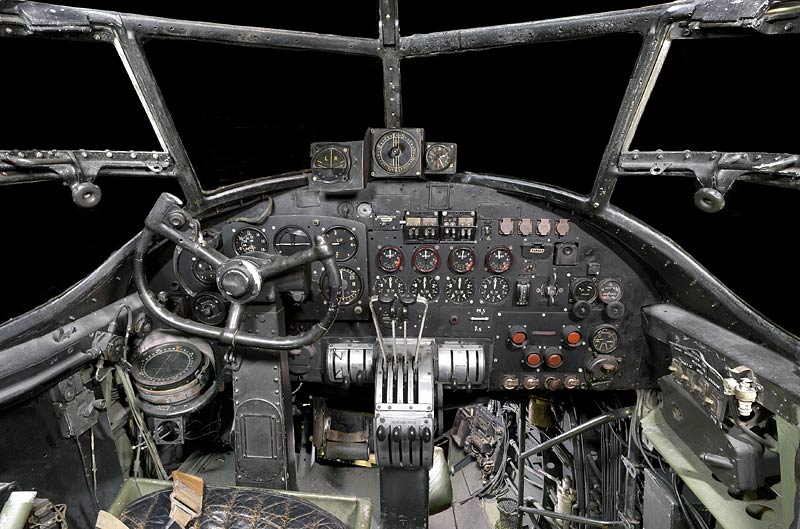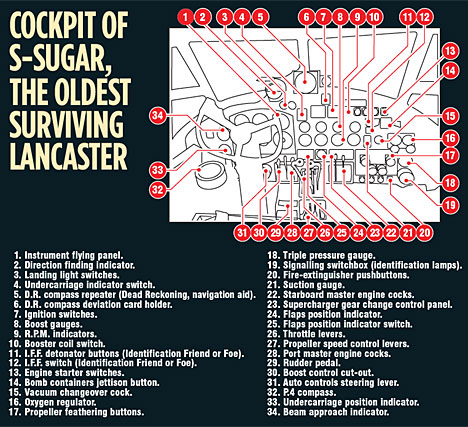On 17th May 1943, the RAF attacked German dams using a specially designed, and ingenious, "bouncing bomb", designed by British inventor Barnes Wallis.
The attack was carried out by Royal Air Force No.617 Squadron, who subsequently became known as the Dambusters.
Yesterday was the 65th anniversary of that operation and, to mark the occasion, the world's only flying Lancaster bomber - the type of plane that took part in the operation - flew over Derwent Dam in Derbyshire, where the Dambusters practised dropping their bombs and getting them on target.
Also taking part in the flypast were a couple of Typhoons from today's 617 Squadron.
Eight RAF aircraft were lost and 53 men were killed in the raids. Also, King George VI helped out with the mission...
Pictured: Lancaster bomber in dramatic flypast to mark 65th anniversary of Dambusters raid
17th May 2008
Daily Mail
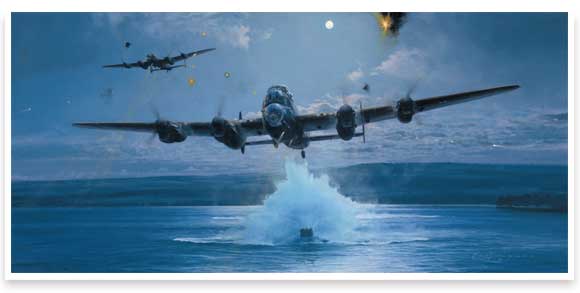
An artist's impression of the RAF dropping a Bouncing Bomb to attack a German dam in 1943. The bomb bounded across the water until it hit its target.
It was one of the most stirring images of the Second World War - a Lancaster bomber coming in terrifyingly low over a huge dam.
And for the last surviving pilot of the epic Dambusters operation, seeing a bomber flying again must have felt like stepping back in time.
Squadron Leader Les Munro, 89, yesterday took part in a spectacular re-enactment to mark the 65th anniversary of the vital raid.
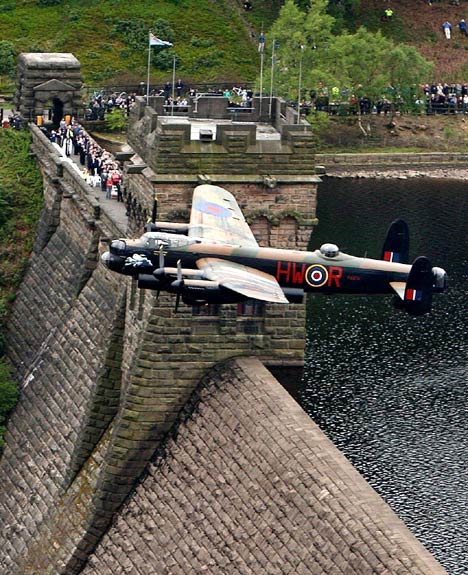
Bombs away: The world's only flying Lancaster makes a low pass over the Derwent Dam
Instead of Germany's Ruhr Valley below, it was Derbyshire but no less poignant for that.
This was the exact spot the famous bombers had painstakingly prepared for their mission in 1943.
In dummy run after dummy run, the elite RAF crews planned their method of attack on the similar German targets.
Amid the roar of the bomber's four Merlin engines yesterday, Mr Munro said: "I'm not one to get emotional about things but it's very nice to be back here.
"It does surprise me that subsequent generations take part in things like this, but it's up to the individual how they react."
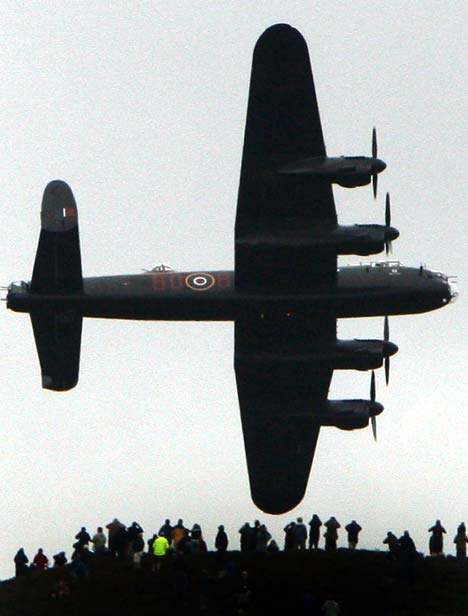
Historic: The Lancaster bombers soars over spectators during its flypast yesterday
Led by Wing Commander Guy Gibson, the pilot and his comrades manned 19 Lancasters from 617 Squadron for the raid.
Thanks to Barnes Wallis's extraordinary “bouncing bomb”, two dams were destroyed but eight British aircraft and 53 men were lost.
Actor Richard Todd, 88, who played Gibson in the famous 1954 film about the mission laid a wreath for the dead yesterday.
For the flypast, a Battle of Britain Memorial Flight's Lancaster was chosen to lead, followed by a Spitfire, a Hurricane and two Tornado fighters from the present 617 Squadron.
All the planes flew from RAF Coningsby in Lincolnshire to take part in the event, which was preceded by a special memorial service on top of the dam.
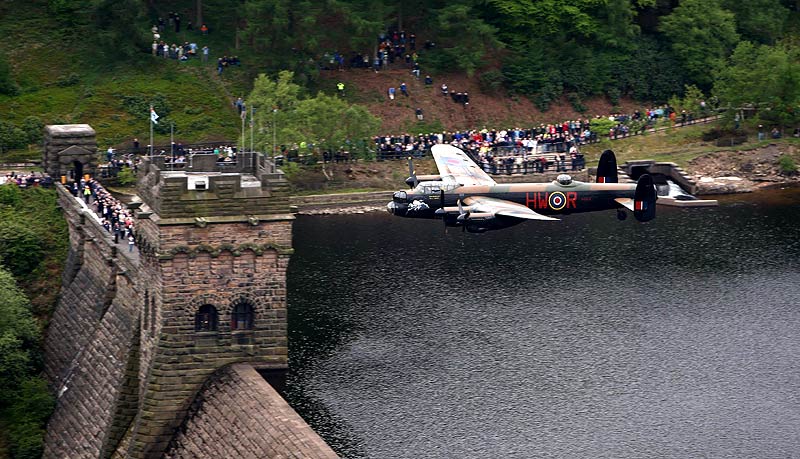 Crowds throng the riverbank in Derbyshire as the Lancaster completes its anniversary flyby
Crowds throng the riverbank in Derbyshire as the Lancaster completes its anniversary flyby

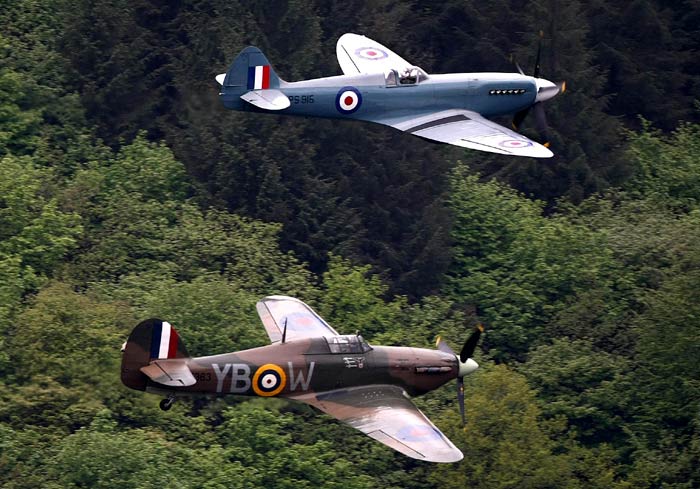
Fighter support: A Supermarine Spitfire, top, and a Hawker Hurricane in formation

Squadron Leader Munro was accompanied by Michael Gibson, the nephew of Wing Commander Guy Gibson.
Poppies were scattered on the water of the reservoir during the service and two wreaths were also laid in the gatehouse.
Todd said: "It's the most wonderful sight, watching the old Lancaster flying over the dam.
It's a wonderful sight and sound.
"It's very exciting, moving and memorable, I just wish the weather had been a little bit kinder. It's very cold but luckily it's good enough for the fly-past to take place."
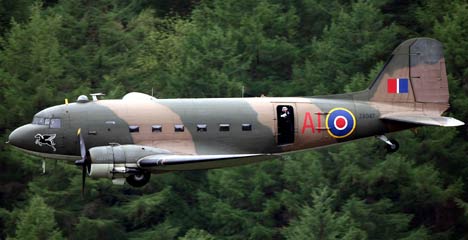 Commemoration: Douglas DC-3 transport aircraft takes part in yesterday's anniversary
Commemoration: Douglas DC-3 transport aircraft takes part in yesterday's anniversary

Andrew Wallis, a musician from Huddersfield, 46, the grandson of Sir Barnes Wallis, the aircraft engineer who devised and planned the raids, was also at the ceremony.
He said: "We're very humbled in thinking that all these people lost their lives so that we could be here today. My grandfather was always very upset about what happened, how many of the pilots and air crew died.
"It pained him for the rest of his life, that he felt in some way responsible. I'm trying to suppress my emotions in some way otherwise I would end up bursting into tears.
"For me, it's the humbling side of it and the fact that I feel some small part of it all. It takes great people to keep everything going. Humanity as a whole is so fragile.
"When the Lancaster went over, it was very exhilarating, the sound, the history."
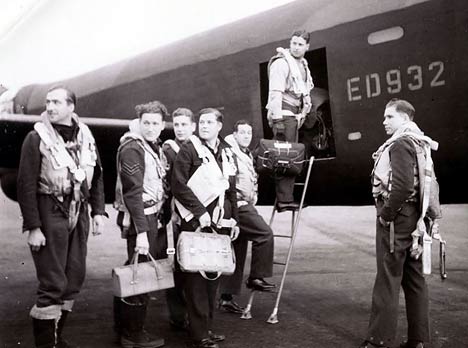
Wing Commander Guy Gibson of 617 squadron, boarding Lancaster G
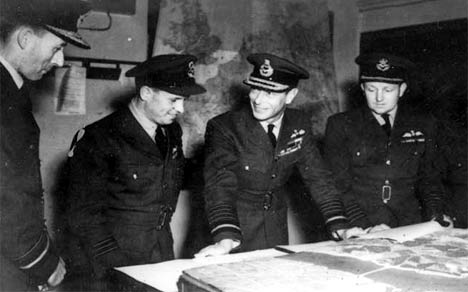
Royal approval: (From left to right) Air Vice-Marshall Ralh Cochrane, Wing Commander Guy Gibson, King George VI and Group Captain John Whitworth discuss Operation Chastise in 1943
After the wreaths were laid at exactly 10.30am, the Lancaster bomber came into view at the top of the Derwent Valley and flew low at 100ft in between the two towers of the dam.
It then banked away before circling to return over the dam again. On its third fly-past it was accompanied by two Tornado planes from today's 617 Squadron.
After its final fly-past, a Spitfire and a Hurricane flew over the dam and finally a Dakota transport plane flew past as hundreds of air enthusiasts and servicemen and women watched.
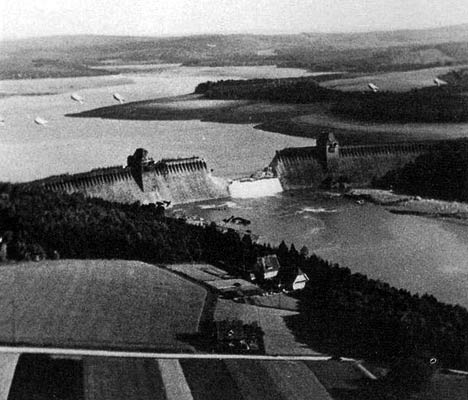
Aftermath: The wrecked Mohne Dam with the massive breach caused by the Dambusters 617 Squadron
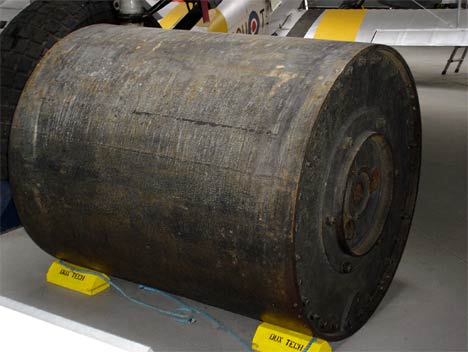
Deadly: A prototype of the so-called 'bouncing bomb' developed by Barnes Wallace
dailymail.co.uk
The attack was carried out by Royal Air Force No.617 Squadron, who subsequently became known as the Dambusters.
Yesterday was the 65th anniversary of that operation and, to mark the occasion, the world's only flying Lancaster bomber - the type of plane that took part in the operation - flew over Derwent Dam in Derbyshire, where the Dambusters practised dropping their bombs and getting them on target.
Also taking part in the flypast were a couple of Typhoons from today's 617 Squadron.
Eight RAF aircraft were lost and 53 men were killed in the raids. Also, King George VI helped out with the mission...
Pictured: Lancaster bomber in dramatic flypast to mark 65th anniversary of Dambusters raid
17th May 2008
Daily Mail

An artist's impression of the RAF dropping a Bouncing Bomb to attack a German dam in 1943. The bomb bounded across the water until it hit its target.
It was one of the most stirring images of the Second World War - a Lancaster bomber coming in terrifyingly low over a huge dam.
And for the last surviving pilot of the epic Dambusters operation, seeing a bomber flying again must have felt like stepping back in time.
Squadron Leader Les Munro, 89, yesterday took part in a spectacular re-enactment to mark the 65th anniversary of the vital raid.

Bombs away: The world's only flying Lancaster makes a low pass over the Derwent Dam
Instead of Germany's Ruhr Valley below, it was Derbyshire but no less poignant for that.
This was the exact spot the famous bombers had painstakingly prepared for their mission in 1943.
In dummy run after dummy run, the elite RAF crews planned their method of attack on the similar German targets.
Amid the roar of the bomber's four Merlin engines yesterday, Mr Munro said: "I'm not one to get emotional about things but it's very nice to be back here.
"It does surprise me that subsequent generations take part in things like this, but it's up to the individual how they react."

Historic: The Lancaster bombers soars over spectators during its flypast yesterday
Led by Wing Commander Guy Gibson, the pilot and his comrades manned 19 Lancasters from 617 Squadron for the raid.
Thanks to Barnes Wallis's extraordinary “bouncing bomb”, two dams were destroyed but eight British aircraft and 53 men were lost.
Actor Richard Todd, 88, who played Gibson in the famous 1954 film about the mission laid a wreath for the dead yesterday.
For the flypast, a Battle of Britain Memorial Flight's Lancaster was chosen to lead, followed by a Spitfire, a Hurricane and two Tornado fighters from the present 617 Squadron.
All the planes flew from RAF Coningsby in Lincolnshire to take part in the event, which was preceded by a special memorial service on top of the dam.



Fighter support: A Supermarine Spitfire, top, and a Hawker Hurricane in formation

Squadron Leader Munro was accompanied by Michael Gibson, the nephew of Wing Commander Guy Gibson.
Poppies were scattered on the water of the reservoir during the service and two wreaths were also laid in the gatehouse.
Todd said: "It's the most wonderful sight, watching the old Lancaster flying over the dam.
It's a wonderful sight and sound.
"It's very exciting, moving and memorable, I just wish the weather had been a little bit kinder. It's very cold but luckily it's good enough for the fly-past to take place."
 Commemoration: Douglas DC-3 transport aircraft takes part in yesterday's anniversary
Commemoration: Douglas DC-3 transport aircraft takes part in yesterday's anniversary
Andrew Wallis, a musician from Huddersfield, 46, the grandson of Sir Barnes Wallis, the aircraft engineer who devised and planned the raids, was also at the ceremony.
He said: "We're very humbled in thinking that all these people lost their lives so that we could be here today. My grandfather was always very upset about what happened, how many of the pilots and air crew died.
"It pained him for the rest of his life, that he felt in some way responsible. I'm trying to suppress my emotions in some way otherwise I would end up bursting into tears.
"For me, it's the humbling side of it and the fact that I feel some small part of it all. It takes great people to keep everything going. Humanity as a whole is so fragile.
"When the Lancaster went over, it was very exhilarating, the sound, the history."

Wing Commander Guy Gibson of 617 squadron, boarding Lancaster G

Royal approval: (From left to right) Air Vice-Marshall Ralh Cochrane, Wing Commander Guy Gibson, King George VI and Group Captain John Whitworth discuss Operation Chastise in 1943
After the wreaths were laid at exactly 10.30am, the Lancaster bomber came into view at the top of the Derwent Valley and flew low at 100ft in between the two towers of the dam.
It then banked away before circling to return over the dam again. On its third fly-past it was accompanied by two Tornado planes from today's 617 Squadron.
After its final fly-past, a Spitfire and a Hurricane flew over the dam and finally a Dakota transport plane flew past as hundreds of air enthusiasts and servicemen and women watched.

Aftermath: The wrecked Mohne Dam with the massive breach caused by the Dambusters 617 Squadron

Deadly: A prototype of the so-called 'bouncing bomb' developed by Barnes Wallace
dailymail.co.uk
Last edited:
